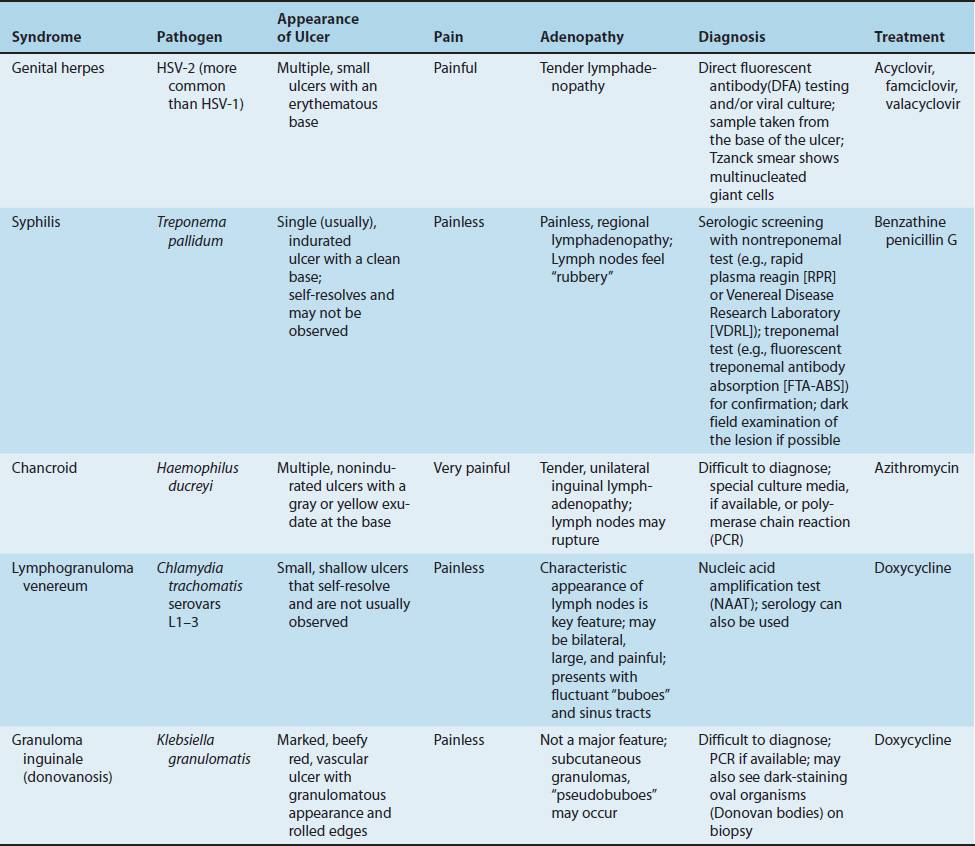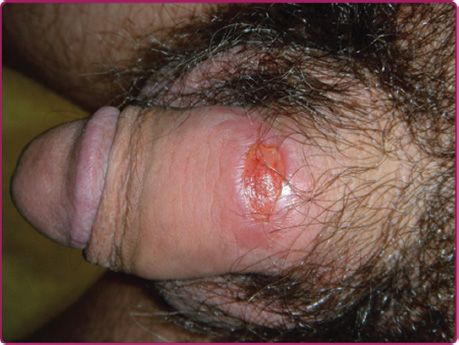74
Pelvic Infections
CHAPTER CONTENTS
INTRODUCTION
Infections in the pelvic organs and surrounding structures comprise a heterogenous group of diseases. They primarily affect sexually active women and men. Many of the pathogens implicated are sexually transmitted, so an important facet of management is partner notification and treatment, as well as patient education regarding safe sexual practices. Among sexual transmitted infections, major syndromes that will be discussed are genital ulcer disease, vaginitis, cervicitis, pelvic inflammatory disease, urethritis, and prostatitis.
GENITAL ULCER DISEASE
Definition
Genital ulcer disease manifests as a breach in the skin or mucosa of the genitalia, usually caused by a sexually transmitted infection. Of these infections, herpes simplex virus type 2 (HSV-2) is the most common etiology in most geographic areas, followed by syphilis and chancroid. The most important noninfectious cause is Behçet’s disease.
Pathophysiology
The mechanisms by which ulcers are produced by pathogens are incompletely understood, and there are different mechanisms of injury depending on the pathogen. In chancroid, a cytotoxin secreted by Haemophilus ducreyi may be important in epithelial cell injury.
Clinical Manifestations
Although the various lesions may have a characteristic appearance, it is important to note that local epidemiology is an important consideration because lesions may appear in an atypical fashion. The appearance of the ulcer, whether it is painful, and the nature of the associated lymphadenopathy may be clues in the etiology of the ulcer. Figure 74–1 shows several vesicles on the shaft of the penis. The vesicular lesions are typically painful. The vesicles can then progress to form shallow ulcers. Figure 74–2 shows the chancre of primary syphilis. It is a painless lesion with a shallow base and a firm, rolled edge. Table 74–1 describes the important clinical features of genital ulcer lesions, their diagnostic procedures, and treatment.
FIGURE 74–1 Genital herpes caused by herpes simplex virus-2. Note group of vesicles on shaft of penis. (From Wolff K, Johnson R, Saavedra A (eds): Fitzpatrick’s Color Atlas & Synopsis of Clinical Dermatology, 7th ed. New York: McGraw-Hill, 2013.)
FIGURE 74–2 Chancre of primary syphilis caused by Treponema pallidum. Note shallow ulcer with clean base and rolled edge. (Used with permission from Goldsmith LA, et al. Fitzpatrick’s Dermatology in General Medicine. 8th ed. New York: McGraw-Hill, 2012. Copyright © 2012 by The McGraw-Hill Companies, Inc.)
Pathogens
Common infectious etiologies of genital ulcer disease include HSV-2 (causing genital herpes), Treponema pallidum (causing primary syphilis), and H. ducreyi (causing chancroid). Less common pathogens include Chlamydia trachomatis serovars L1–3 (causing lymphogranuloma venereum) and Klebsiella granulomatis (causing granuloma inguinale, also known as donovanosis).
Diagnosis
A thorough sexual and medical history, followed by the physical examination, are important for diagnosis. Although clinical characteristics can be very helpful, there is often overlap in presentation, and there may also be multiple syndromes copresenting. Therefore, diagnostic testing is highly recommended. Testing for other sexually transmitted diseases including human immunodeficiency virus (HIV) is also important because there is often cotransmission of multiple pathogens (see Table 74–1).
TABLE 74–1 Genital Ulcers: Clinical Features, Diagnosis, and Treatment

Treatment
The drug of choice for genital herpes is acyclovir or one of its derivatives, famciclovir or valacyclovir. Primary and secondary syphilis are treated with a long-acting penicillin, benzathine penicillin G. The drug of choice for chancroid is azithromycin, whereas for lymphogranuloma venereum, it is doxycycline (see Table 74–1).
Empiric treatment is often used before diagnostic tests return. As for most sexually transmitted infections, treatment that involves one dose and that is observed is preferred if possible.
Prevention
Consistent use of condoms is an important measure that can prevent genital ulcers. In some cases, primary prevention of HSV infection can be undertaken by treatment of the negative partner in serodiscordant couples with acyclovir or one of its derivatives. Prophylaxis with these drugs can be effective in preventing recurrences of HSV outbreaks in patients who have had frequent occurrences, especially among those who are immunosuppressed. Partner notification and treatment are important prevention strategies as well.
VAGINITIS
Definition
Vaginitis is inflammation of the vagina that can result in discharge, itching, and pain. Common causes of vaginitis are candidiasis, trichomoniasis, and bacterial vaginosis. Noninfectious causes include lichen planus and certain medications (e.g., oral contraceptives).
Pathophysiology
Stay updated, free articles. Join our Telegram channel

Full access? Get Clinical Tree




